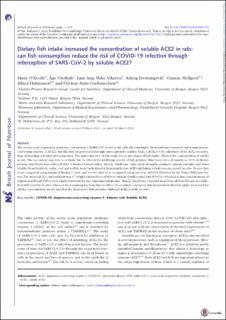Dietary fish intake increased the concentration of soluble ACE2 in rats. Can fish consumption reduce the risk of COVID-19 infection through interception of SARS-CoV-2 by soluble ACE2?
| dc.contributor.author | O'Keeffe, Maria | |
| dc.contributor.author | Oterhals, Åge | |
| dc.contributor.author | Vikøren, Linn Anja Slåke | |
| dc.contributor.author | Drotningsvik, Aslaug | |
| dc.contributor.author | Mellgren, Gunnar | |
| dc.contributor.author | Halstensen, Alfred | |
| dc.contributor.author | Gudbrandsen, Oddrun Anita | |
| dc.date.accessioned | 2023-05-12T12:09:21Z | |
| dc.date.available | 2023-05-12T12:09:21Z | |
| dc.date.created | 2023-05-08T12:48:45Z | |
| dc.date.issued | 2023 | |
| dc.identifier.citation | British Journal of Nutrition. 2023, 1-8. | |
| dc.identifier.issn | 0007-1145 | |
| dc.identifier.uri | https://hdl.handle.net/11250/3067787 | |
| dc.description.abstract | The severe acute respiratory syndrome coronavirus 2 (SARS-CoV-2) enters the cells after binding to the membrane-bound receptor angiotensin-converting enzyme 2 (ACE2), but this may be prevented through interception by soluble ACE2 (sACE2) or by inhibition of the ACE2 receptor, thus obstructing cell entry and replication. The main objective of this study was to investigate if fish intake affected the concentration of sACE2 in rats. The secondary aim was to evaluate the in vitro ACE2-inhibiting activity of fish proteins. Rats were fed cod muscle as 25 % of dietary protein, and blood was collected after 4 weeks of intervention. Muscle, backbone, skin, head, stomach, stomach content, intestine and swim bladder from haddock, saithe, cod and redfish were hydrolysed with trypsin before ACE2-inhibiting activity was measured in vitro. In vivo data were compared using unpaired Student’s t test, and in vitro data were compared using one-way ANOVA followed by the Tukey HSD post hoc test. The mean sACE2 concentration was 47 % higher in rats fed cod when compared with control rats (P 0·034), whereas serum concentrations of angiotensin II and TNF-α were similar between the two experimental groups. Muscle, backbone, skin and head from all four fish species inhibited ACE2 activity in vitro, whereas the remaining fractions had no effect. To conclude, our novel data demonstrate that fish intake increased the sACE2 concentration in rats and that the hydrolysed fish proteins inhibited ACE2 activity in vitro. | |
| dc.language.iso | eng | |
| dc.title | Dietary fish intake increased the concentration of soluble ACE2 in rats. Can fish consumption reduce the risk of COVID-19 infection through interception of SARS-CoV-2 by soluble ACE2? | |
| dc.title.alternative | Dietary fish intake increased the concentration of soluble ACE2 in rats. Can fish consumption reduce the risk of COVID-19 infection through interception of SARS-CoV-2 by soluble ACE2? | |
| dc.type | Peer reviewed | |
| dc.type | Journal article | |
| dc.description.version | publishedVersion | |
| dc.source.pagenumber | 1-8 | |
| dc.source.journal | British Journal of Nutrition | |
| dc.identifier.doi | 10.1017/S0007114523000776 | |
| dc.identifier.cristin | 2146140 | |
| cristin.ispublished | true | |
| cristin.fulltext | original | |
| cristin.qualitycode | 2 |
Tilhørende fil(er)
Denne innførselen finnes i følgende samling(er)
-
Artikler / Articles [1456]
-
Publikasjoner fra CRIStin [2533]
